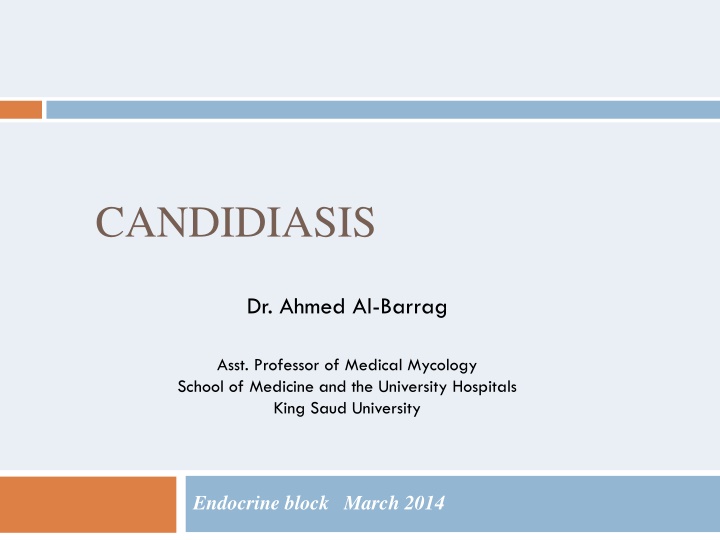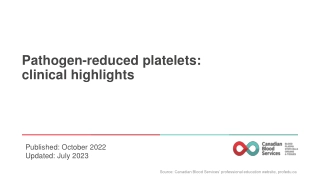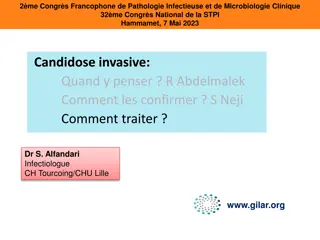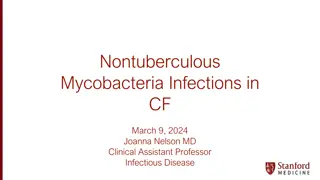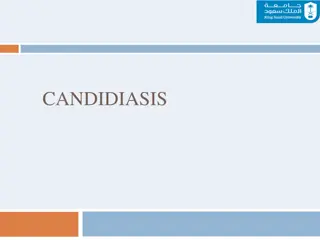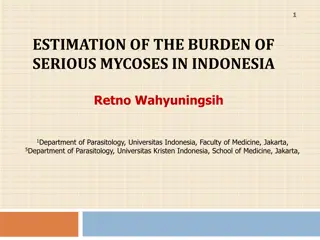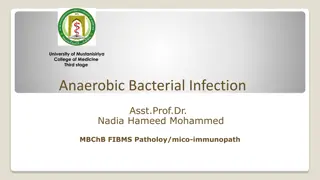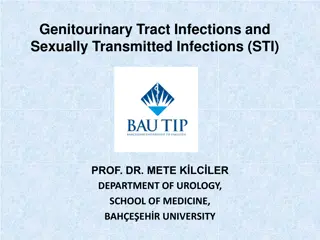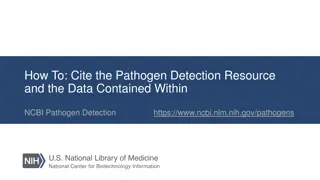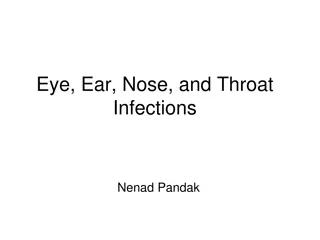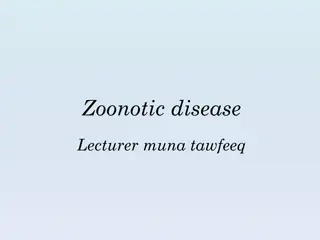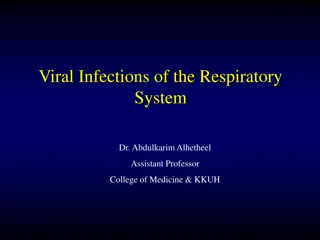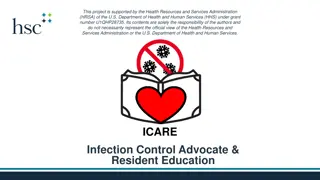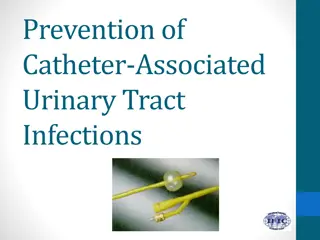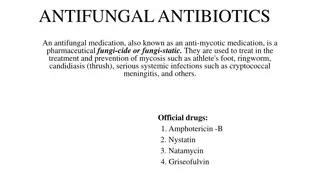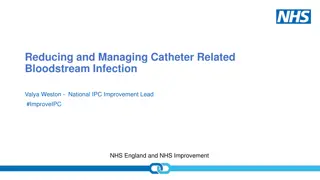Overview of Candidiasis: Pathogen, Infections, and Clinical Settings
Candidiasis is caused by Candida species, common in immunocompromised patients. Learn about the pathogen, infections, clinical settings, laboratory diagnosis, and treatment of this opportunistic infection.
Download Presentation

Please find below an Image/Link to download the presentation.
The content on the website is provided AS IS for your information and personal use only. It may not be sold, licensed, or shared on other websites without obtaining consent from the author.If you encounter any issues during the download, it is possible that the publisher has removed the file from their server.
You are allowed to download the files provided on this website for personal or commercial use, subject to the condition that they are used lawfully. All files are the property of their respective owners.
The content on the website is provided AS IS for your information and personal use only. It may not be sold, licensed, or shared on other websites without obtaining consent from the author.
E N D
Presentation Transcript
CANDIDIASIS Dr. Ahmed Al-Barrag Asst. Professor of Medical Mycology School of Medicine and the University Hospitals King Saud University Endocrine block March 2014
Objectives Students at the end of the lecture will be able to: Acquire the basic knowledge about Candida as a pathogen 1. know the main infections caused by Candida species 2. Identify the clinical settings of such infections 3. Know the laboratory diagnosis, and treatment of these infections. 4.
THE ORGANISM Candida
Candida Candida is a unicellular yeast fungus. It is imperfect reproducing by budding Morphology Microscopy: Budding yeast cells, and Pseudohyphae. Culture:Creamy colony, fast growing on Sabouraud Dextrose agar (SDA), Blood agar (48 hr)
Candida There are many species of Candida (>150) The common species are: Candida albicans, C.parapsilosis C.tropicalis, C.glabrata, C.krusei, Human commensal Oral cavity Skin Gastrointestinal tract Genitourinary tracts
THE DISEASE Candidiasis
Candidiasis Definition: Any infection caused by any species of the yeast fungus Candida. The most common invasive fungal infections in immunocompromised patients 4th most common cause of nosocomial blood stream infection It is considered opportunistic infection
Candidiasis Opportunistic Fungal Infections Alteration in Immunity Physiology Normal flora Damage in the barriers ENDOGENOUS Colonization precedes infection Antibiotic suppression of normal flora, fungal overgrowth Clinical Spectrum of disease?
Candida - Clinical Mucous membrane infections Thrush (oropharyngeal) Esophagitis Vaginitis Cutaneous infections Paronychia (skin around nail bed) Onychomycosis (nails) Diaper rash Balanitis Chronic mucotaneous candidiasis children with T-cell abnormality
Mucocutaneous infections Oropharyngeal Candidiasis Oral thrush: White or grey Pseudomembranous patches on oral surfaces especially tongue with underlying erythema. Common in neonates, infants, elderly In immunocompromised host, e.g. AIDS. Esophagitis Vulvovaginitis : Common in pregnancy, diabetics, use of contraceptives. Thick discharge, itching irritation . Lesion appear as white patches on vaginal mucosa.
Cutaneous infections Intertriginous candidiasis: Infections of skin folds eg. axilla, buttock, toe web, under breast. Erythematous lesion, dry or moist or whitish accompanied by itching and burning. Nail infections: Onychomycosis and paronychia Diaper rash Chronic mucocutaneous candidiasis
Candida - Clinical Urinary tract infection Candidemia Disseminated (systemic, invasive) infection Endophthalmitis (eye) Liver and spleen Kidneys Skin Brain Lungs Bone
Pulmonary Candidiasis Primary pneumonia is less common and could be a result of Aspiration Secondary pneumonia commonly seen with hematogenous candisiasis Immunocompromised patients Isolation of Candida from sputum is not always significant Clinical features Radiology, Other Lab investigations
Candidemia Increased colonization (endogenous or exogenous factors) Damage in host barriers by catheters, trauma, surgery Immunosuppression Central venous catheters (CVC) Disseminated candidiasis (involvement of any organ) Septic shock Meningitis Ocular involvement (retinitis) Fever could be the only clinical manifestation
Candidiasis Laboratory diagnosis Specimen depend on site of infection. Swabs, Urine, Blood, Respiratory specimens, CSF, Blood 1. Direct microscopy : Gram stain, KOH, Giemsa, GMS, or PAS stained smears. Budding yeast cells and pseudohyphae will be seen in stained smear or KOH.
Candidiasis Laboratory diagnosis 2. Culture: Media: SDA & Blood agar at 37oC, Creamy moist colonies in 24 - 48 hours. 3. Blood culture
Candidiasis Laboratory diagnosis Laboratory identification of Yeast Because C. albicans is the most common species to cause infection The following tests are used to identify C. albicans: 1. Germ tube test : Formation of germ tube when cultured in serum at 37 C 2. Chlamydospore production in corn meal Agar Germ tube test 3. Resistance to 500 g/ml Cycloheximide If these 3 are positive this yeast is C.albicans, If negative, then it could be any other yeast, Use Carbohydrate assimilations and fermentation. Chlamydospores of C. albicans in CMA Commercial kits available for this like: API 20C, API 32C Culture on Chromogenic Media (CHROMagar Candida)
Yeast Identification Chromagar Carbohydrates assimilation test , API 20C
Candidiasis Laboratory diagnosis 4. Serology: Patient serum Test for Antigen , e.g. Mannan antigen using ELISA Test for Antibodies 5. PCR
Candidiasis- Treatment Oropharyngeal: Topical Nystatin suspension, Clotrimazole troches ,Miconazole, Fluconazole suspension. Vaginitis: Miconazole, Clotrimazole, Fluconazole Systemic treatment of Candidiasis Fluconazole Voriconazole Caspofungin Amphotericin In candidemia : Treat for 14 days after last positive culture and resolution of signs and symptoms Remove catheters, if possible Points to consider: C. glabrata can be less susceptible or resistant to fluconazole C. krusei is resistant to fluconazole
